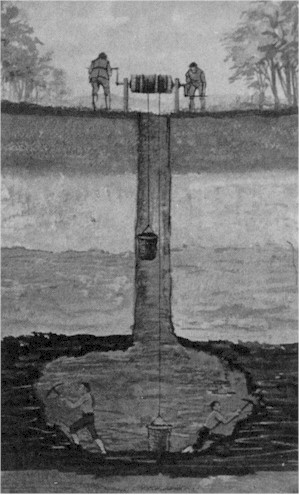Types of Mining in the Area
Coal was extracted from the ground over the years in Castlecomer using three different methods:
- Bell
Mining
- Opencast
Mining
- Conventional
“Pit” mining
Our project deals primarily with the latter “Pit Mining” but in
these pages we will give a description of the other two methods of mining.
Bell Mining
At the time explosives had not been invented, so the coal had to be dug out and broken up with wedges and hammers. On the British mainland it was found that the miners were able to extract about 60% of the coal from these old pits and in the twentieth century open casting was used to mine the remaining 40%. In Castlecomer, however, the old miners removed up to 85% of coal. Open casting was found to be uneconomical when it was tried out.
These pits had to be spaced very close together, sometimes
as close as fifty yards, as there were no water pumps or ventilation fans
available. In those early days the owner or his agent would sink three
pairs of pits. He would then enter into an agreement with master miners as
to the price per cubic yard for the coal produced. The master miners would
bring together the miners and make a deal with them to extract the coal.


Bell Mining
THE
BELL PIT BUCKET
Willie Baker with an original bell pit bucket.
It is about 66cm high. The iron is one inch
thick .The last time it was
used was in 1800s.This bucket was used to carry men as well as coal.

Opencast Mining
We went on a Field Trip to one of the old Opencast Mining pits, which is
located about a mile behind the Castlecomer Brick Factory. From the top of
the pit we could clearly see across the valley to the Deer Park Mines.
Coal was carried in large buckets, suspended from cables similar to the
cable cars on the Ski-slopes, from the opencast and other pits nearby to
Deer Park where it was graded and transported by train to all parts of the
world.


View from the top of one of the pits
We were amazed at the dept of the pits and the amount of earth that
has been dug out. The area is known as the 28 Acres and what was once
acres of level pasture is now a massive landscape of pits and lakes. In a
way it is beautiful, certainly unusual. You could have great fun playing
there. The hills and the hollows provide great places to hide in a game of
“Cowboys & Indians” or “Cops & Robbers”. On the other
hand, the landscape is destroyed. Mother earth has been robbed of her
insides and a gaping hole has been left in her side. Other pits locally
have been filled in and returned to pasture. We are not sure which is the
best.
Some of us went down to the very bottom of the pits while others
stayed at the very top. Looking at each other was like looking at ants,
such was the height. The area is very dangerous as you could fall into
some of the pits and not be able to get out. One of the lakes in
particular is supposed to be more than fifty feet deep.
This pit is particularly interesting because it served two
industries. Firstly the coal was taken from it and in later years when the
coal was all gone the local Brick Factory (Ormonde Brick) took “fire
clay” from it to make bricks. This fireclay is bluish in colour and is
like “maula”. In other places locally where there is no coal,
fireclay is present and is known
as “yellow clay”
Opencast mining is carried out in the following way:
- Large
machines move into a field and strip away the earth until the coal
seam is reached.
- The
coal is then cut away and transported to a sorting area where it is
broken, cleaned and graded for sale.
- If
there is a water problem then large pumps are used to take away the
water.
- When
the coal runs out the area is often just abandoned.
- Sometimes the pit is used as a landfill and eventually the land is
restored to it’s original state.
When
we visited the opencast we saw clearly the different layers in the earth's
crust. We could see soil, rock, shale and the area from which the coal was
removed. There is also plenty of fireclay left. We found some coal in the
sides of the pits, which we brought back to school and washed. The coal
was anthracite and was very shiny. This coal was the best quality in
Europe.


Moving through the Opencast


Looking across from the Rock Pit in the Upper Hills to the Deerpark (centre) An aerial rope transported coal across these hills
Where once there was coal now children are eating lunch